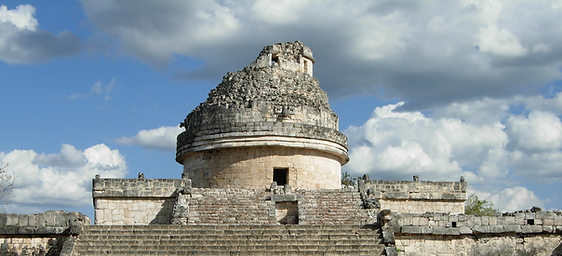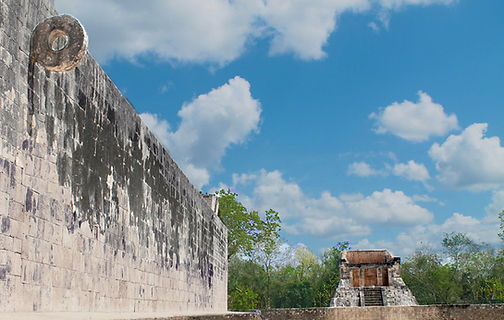
OUR ROOMS

Hacienda Chichen's operational protocols includes a complete sanitization in each room, in addition we have certified our house team with a Legionella pneumophila and COV19 strict cleaning practices for you to have additional healthy environment, during your stay at the hacienda.
Take time to be in contact with Mother Nature at our botanical gardens and Maya Jungle Reserve, where wild flora and fauna will bring you full surprises as you come in contact with its creative life.




Chichen Itza Facts
A Majestic Maya Archaeological Site in Yucatan, Mexico


The Maya name: "Chichen Itza" means " at the edge of the Itza's well." This derives from chi', meaning "mouth" or "edge", and ch'e'en, meaning "well." Itza is the name of an ethnic-lineage group that dominated the northern peninsula of Yucatan, Mexico prior to the Spanish Conquest. It is believed that "Itza" derives from the Maya itz, meaning "magic", meaning "water;" Itza means: "Water Magicians." Archaeologists today believe that this majestic Mayan city rose as a prominent power towards the end of the Mayan Early Classic Period (600 AD) and current scholastic data places Chichen Itza's fall around AD 1000. Ancient Maya created an intimate relationship between Yucatan endemic venomous snakes and their cultural traditions, including their majestic architectural symbolic designs and with their Cosmo-vision. Chichen Itza was inscribed on the UNESCO World Heritage list in 1988 and was listed as one of the Seven Wonders of the World in 2007.
A picture is worth a thousand words!
Two Different Experiences, One Site, Your Choice:








"It is common practice to sell tourists a "Day-Trip or Bus Tour to Chichen Itza" which is a sad way to visit such majestic archaeological zone. Such experience is not your best choice! We Recommend you to avoid these type of visit, for you will spend more time traveling in the tour bus than at the site! Rather we highly recommend you plan to stay at least a night at Hacienda Chichen Resort if you can, the hotel is a wellness destination in its own right, and offers the additional joy of early morning visits to Chichen Itza’s temples from the hotel’s private entrance…. an awesome experience for anyone!"
By Yucatan Adventure Editors
Eco Travel Magazine
A Brief Introduction & Information About
Chichen Itza's Ancient Architectural Urban Design

The impressive urban design found in Chichen Itza is extraordinary well planned, ancient Maya builders created clusters of pyramids and Mayan Temples in sets of clusters. the vast Chichen Itza urban zone extends far away from the area visited today by tourists, Hacienda Chichen Resort is not only a Colonial landmark but part of this ancient city grounds.
The most visited cluster includes the New Seven Wonders majestic Maya pyramid of Kukulkan. The four most well known clusters of Mayan pyramids and temples within the ancient Maya city of Chichen Itza are:
-
The Great North Platform, which includes Kukulkan Pyramid, Great Ball Court, Temple of the Jaguars, Tempe of the Warriors, Thousand Columns Market, Venus Platform, and to the north the Sacred Cenote of Chichen Itza.
-
The Ossario Group, which includes the Ossario pyramid,the Xtoloc temple, and the cenote of the Xtoloc.
-
The Central Group, includes the Maya Observatory or El Caracol, the group of Las Monjas and La Iglesia, plus the lovely Mayan temple of Akab Dzib.
-
Old Chichen or Chichen Viejo is located at the far south end of Chichen Itza visited zone. Old Chichen is not openned to the public.
Some Maya pyramids were built to reflect astronomical events. It’s no secret that the Maya were advanced astronomers—what’s lesser known is that many great Maya structures, such as El Castillo (Temple of Kukulcan) pyramid at Chichen Itza, reflect astronomical events as well as the importance ancient Maya gave culturally to a variety of Yucatan snakes in their region.
During equinoxes, an undulating shadow called the “serpent” slithers along the side of Kukulcan’s northern staircase. This is caused by the angle of the sun hitting the nine main terraces. Spring Equinox is the most notable Light and Shadow effect along the staircase of this magnificent Maya pyramid. Read More Facts HERE, but first know this:
Most Popular Day to Visit: March Spring Equinox - Kukulcan Pyramid displays a beautiful light and shadow image of (the Great Snake) Kukulcan descending to Earth every Spring Equinox, March 21st. Come experience such magnificent event and stay at Hacienda Chichen Resort.
CHICHEN ITZA FACTS: MAYA TEMPLES AND MAYA ARCHITECTURE
Mayan Temples academic explorations have confirmed that most ancient Maya temples where built over former structures or a top large platforms that grouped a set of structures, among the most famous Maya pyramids and temples are:


-
The Maya Observatory also known as the Caracol, in the south cluster of Maya temples in Chichen Itza, is an impressive building dedicated to the study of the skies by ancient Maya astronomers, this Maya observatory is linked to the orbit of Venus. El Caracol’s front staircase targets Venus’s most northern position, and the corners of the building align with the sun’s position at the summer solstice sunrise and winter solstice sunset.
-
Great Ball Court is also within the Great North Platform series of Mayan temples in Chichen Itza. It is known as Pok-Ta-Pok in Maya, and El Juego de Pelota in Spanish; there are several smaller Ball Courts in this archaeological site but the Great Ball Court at Chichen Itza, Yucatan, Mexico, is the most impressive and larger in ancient Mesoamerica, measuring 166 X 68 meters in length and two long 12 meter high walls holding the two stone carved ball rings representing the feather serpent.
-
Kukulkan Pyramid also known as El Castillo dominates the Great North Platform Series; this Mayan temple is in harmony with the Mayan Solar Calendar in its numeric set of steps, platforms, and geometric design. The Kukulkan Pyramid is a masterpiece of ancient Mayan Cosmovision, the pyramid has a ground plan of square terraces with central stairways decorated with two feather serpents tails up and their heads resting at the ground. Only two of the four sides of Mayan temple have been restored by Mayan archaeologists. the north side of the pyramid is where the amazing "light and shadow" coming of Kukulkan (symbolized by the feather serpents) descends during an equinox sunrise and sunset each year. Yaxkin Spa offers guests a holistic Mayan experience: KukulKan Ceremony based on ancientMayan Cosmovision.


-
Temple of the Warriors and the Group of the Thousand Columns The archeological expedition and restoration of these building was conducted by the Carnegie Institute from 1925-1928, with Earl H. Morris as one of the key members of the restoration. Chichen Itza's Temple of the Warriors features sculpted feather serpent columns, (Yucatan endemic venomous snakes) at its top platform framing an impressive sculpture of the Chac Mool used in ancient times as an altar for sacrifices; the temples has an inner chamber covered with painted stucco Mayan frescos (not opened to the public nowadays). The Group of the Thousand Columns connects with the Main Market complex, both part of the Great North Platfom series which has many other Mayan templesand platforms for visitors to enjoy during their visit to Chichen Itza, Yucatan, Mexico.
-
The Ossario is a mid-size step-style pyramid within the Ossario Group complex of Mayan temples found just south of the Kukulkan pyramid series. In the late 1800s Edward H. Thompson excavated the Ossario pyramid and its cave in the late 1800s and found jade, pottery, human bones, and ancient Mayan artifacts.


-
Las Monjas (Nunnery) is one of the most notable Puuc style Mayan-temple structure at Chichen Itza; Las Monjas complex represents the Terminal Classic buildings constructed in the Puuc architectural fashion within Chichen Itza, similar to the designs found in Kabah, and Uxmal, Yucatan, Mexico. Early explorer August Le Plongeon revealed an older structure within this temple. the Anexo Este building constructed annex to this temple has a highly Chenes Style decorated with many masks of Chac the Rain God and serpents.
-
Akab Dzib (Temple of the Obscure Writing) constructed to the east of the Nunnery, showcases Mayan glyphs which gave it is current "yet to be deciphered" name. Trace of original red chac wall paint colors are still observed in this Maya ruin that may be the oldest building at Chichen Itza, Yucatan, Mexico.
-
Old Chichen Complex or Chichen Viejo is only opened to archaeologists and is located adjacent to Hacienda Chichen private Mayan Jungle Reserve in the south region of Chichen Itza. Many of Old Chichen temples feature the Maya Puuc architectural design. The past ten years, Dr. Merle Greene has dedicated many summers to work recording many of the Mayan stone-carvings in these Mayan temples; a lovely collection of her original "rubbings" can be seen by Hacienda Chichen guests at the hotel's Merle Greene's Museum.

MAYA CALENDAR SYSTEM, CYCLES & FACTS
Ancient Maya time-keepers designed a highly advance way of keeping time interlocking three calendars or space/time cycles; together these Mayan calendars form a truly amazing understanding of the Cosmic bodies inter-relationships and our Universe of the Moon orbiting the Earth, planet Earth orbiting our solar planet, and our solar planet's own path in our galaxy the Milky Way. Some Maya Calendar facts:
-
Tzolkin Maya Moon Calendar has a cycle unit every 13 lunar unit of 20 days.
-
Haab Mayan Solar Calendar has a cycle of 365 days divided into 18 months of 20 days, plus a period of 5 days left over at the end of the year. This short 5 day month is called “Uayeb,” the resting of the year.
-
The Sacred or Long Count Calendar Together they blend with the larger Mayan calendar to create a complete 52-Haab unites of 18,980 days that record the solar system's own space/time cycle.
The most important calendar cycle for the Maya is Tzolkin, a ritual calendar of 260 days also known as the Sacred Almanac and J'Men Elder Mayan Priests (Shamans) continue using its count to celebrate their Mayan sacred rituals and ceremonies. It is composed of 13 months, each with 20 days. Every day in the 260 day calendar has a unique corresponding position in time as well as in the “Haab” or the solar 360 + 5 day Maya calendar. Each day’s position in the calendars only repeats itself every 52 solar years.
Hacienda Chichen & The Carnegie Institute
Chichen Itza's Maya Temples Reconstruction

Hacienda Chichen is part of Yucatan's history; from its construction atop a Maya temple to represent Mexico as an example of Sustainable Tourism during the COP16 United Nations Climate Change Conferences. The property has housed renowned archaeologists and Mayan scholars long before the 1920s when the Carnegie Institution organized the First Maya Academic Research Expedition. These Mayan scholars built their cottages within the grounds of the Hacienda Chichen property, creating a village-like ambiance while they studied the Maya and worked to reconstruct the most impressive Maya pyramids and urban temples of Chichen Itza's northern area. Nowadays, their cottages house Hacienda Chichen Resort guest rooms.



